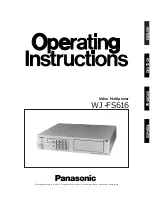
Model DMM7510 7½ Digit Graphical Sampling Multimeter Reference Manual
Section 2: General operation
DMM7510-901-01 Rev. B / May 2015
2-7
EXT TRIG
IN/OUT terminal
This terminal is a TTL-compatible input/output line with a 0 to 5 V
logic signal. You can use this line for triggering by using the transition
of the line state to initiate an action. The instrument can generate
output trigger pulses and detect input trigger pulses on this line. Refer
to
(on page 3-59) for details.
Line fuse and
power receptacle
Connect the line cord to the power receptacle and a grounded AC
power outlet. The line fuse, located just above the power
receptacle, protects the power line input of the instrument. For
safety precautions and other details, see
(on page 1).
LAN port
Supports full connectivity on a 10 Mbps or 100 Mbps network. The
Model DMM7510 is an LXI version 1.4 Core 2011 compliant
instrument that supports TCP/IP and complies with
IEEE Std 802.3 (ethernet LAN). See LAN communication.
USB port
USB-B connection for communication, control, and data transfer.
For details, see
Digital I/O port
A digital input/output port that detects and outputs digital signals.
he port provides six digital I/O lines. Each output is set high (+5 V)
or low (0 V) and can read high or low logic levels. Each digital I/O
line is an open-drain signal. Refer to
(on page 3-47) for
information.
TSP-Link ports
TSP-Link
®
system expansion interface, which test system builders
can use to connect multiple instruments in a master and
subordinate configuration. TSP-Link is a high-speed trigger
synchronization and communication bus. For details, see
Link System Expansion Interface
(on page 3-104).
LAN reset
Reverts the LAN settings and the instrument password to default
values. See
(on page 2-77) for more
information.
Chassis ground
Ground screw for connections to chassis ground. This provides a
connection terminal to the equipment frame.
IEEE-488 port
GPIB connection; the default setting for the Model DMM7510 is
16. Refer to
(on page 2-66).
















































